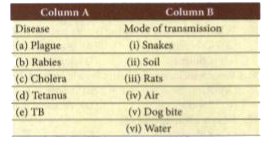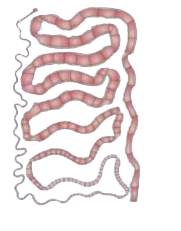Complete Solutions to CONSOLIDATED EXERCISE of chapter HEALTH, HYGIENE, AND DISEASES of Class 9 book with complete answers and questions
| Class 9 | BIOLOGY |
| Chapter | HEALTH, HYGIENE, AND DISEASES |
| CENGAGE BIOLOGY | CONSOLIDATED EXERCISE |
| Number Of Questions | 15 |
| Academic Year | 2023-24 |
Read the following passage and answer the questions:
Our body has the defence system to protect against invading microbes. The outermost line of defence is the barrier that prevents the entry of microbes into the body, and if they enter, phagocytic cells kill the microbes. This forms the local defence system of the body. The innermost line of defence includes formation of specific antibodies that combine with the antigen (microbe) and then destroy it. This is called specific immunity.
What are the mechanical barriers that prevent microbial entry into our bodies?
View SolutionRead the following passage and answer the questions:
Our body has the defence system to protect against invading microbes. The outermost line of defence is the barrier that prevents the entry of microbes into the body, and if they enter, phagocytic cells kill the microbes. This forms the local defence system of the body. The innermost line of defence includes formation of specific antibodies that combine with the antigen (microbe) and then destroy it. This is called specific immunity.
Name the different secretions of our body which have antimicrobial properties.
View SolutionRead the following passage and answer the questions:
Our body has the defence system to protect against invading microbes. The outermost line of defence is the barrier that prevents the entry of microbes into the body, and if they enter, phagocytic cells kill the microbes. This forms the local defence system of the body. The innermost line of defence includes formation of specific antibodies that combine with the antigen (microbe) and then destroy it. This is called specific immunity.
How is the local defence system different from the antibody-producing specific immune system?
View SolutionMatch the following :

View SolutionIn 2009, a new strain of virus spread worldwide and caused about 17,000 deaths by the start of 2010. In June 2009, WHO declared it pandemic. The virus that was responsible for this global outbreak was _______
View SolutionThe use of vaccine is for _______ (treatment/prevention) of the disease
View SolutionThe specific protein molecule (globulin) produced by the body against the foreign substance (antigen) is called _________
View SolutionThis gas is colourless, odourless, tasteless, non-irritating, toxic, and a major pollutant in most urban areas due to vehicular exhaust. It also binds to haemoglobin, which is the oxygen-carrying component in blood. The gas is ________
View SolutionIn this condition, the body has temperature of more than `40.6^@C` due to environmental heat exposure and lack of thermoregulation. The condition is called ________
View SolutionIdentify the pathogen. Also, name the disease it causes.

View SolutionMark the following statements as True or False: Lack of physical exercise can cause disease.
View SolutionMark the following statements as True or False: Diarrhoea is caused by bacterial pathogens only.
View SolutionMark the following statements as True or False: Fleas which cause plague are wingless.
View SolutionMark the following statements as True or False: The 'Red Lion with Sun' symbol, used by Iran, is still recognised with equal status to the 'Red Cross', 'Red Crescent', and 'Red Crystal' symbols.
View SolutionMark the following statements as True or False: Cats can cause rabies.
View Solution
CONSOLIDATED EXERCISE questions and complete solutions for chapter HEALTH, HYGIENE, AND DISEASES of CENGAGE BIOLOGY of Class 9